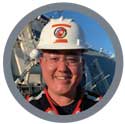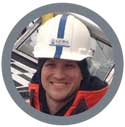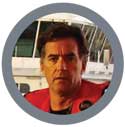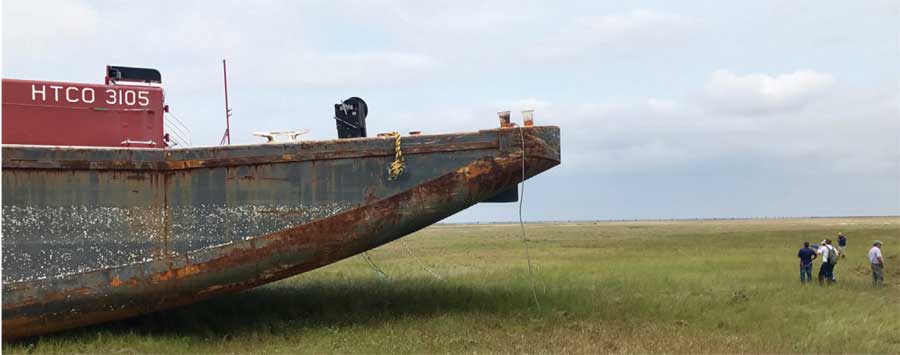November/December 2019
Mariner’s Intuition, Engineer’s Expertise
BY EVA KAPLAN-LEISERSON
In September, the South Korean cargo ship Golden Ray capsized off the coast of Georgia with its load of 4,200 new cars. News reports covered the dramatic rescue of trapped crew members, who faced temperatures reaching 140 degrees Fahrenheit.
Once the rescue was complete, the focus turned to the salvage operation. The 656-foot vessel lay on its side in the water, leaking fuel, which had to be removed and environmental mitigation measures taken. The ship can’t be righted safely, so the most recent plan was to disassemble it in place.
When a ship or other vessel experiences a grounding, collision, capsizing, or fire, the responders’ order of priority is: save lives, save the environment, and save property.
To that process, salvage engineers bring a multidisciplinary background that often joins expertise in naval architecture and marine engineering to knowledge of disciplines such as structural, mechanical, and materials engineering.
Salvage engineers develop a problem-solving mindset and an ability to be flexible in a field that provides not just the opportunity but also the requirement to think creatively. Experienced practitioners describe the field as a blend of engineering and art.

Lt. Daniel Burke, P.E.
NSPE member
Marine inspector, Coast Guard Sector Puget Sound
Former team leader,
Coast Guard Salvage Engineering Response Team (SERT)
Salvage engineering is a small niche, and many involved have experience on the Coast Guard’s Salvage Engineering Response Team. It’s made up of 8–10 active duty officers and a civilian salvage supervisor, all with marine industry experience. They provide 24/7 technical support to local Coast Guard offices dealing with marine salvage and wreck removal, reviewing plans submitted by contracted salvors and overseeing operations.
Daniel Burke worked as a member and team leader on SERT, under the auspices of the Coast Guard’s Marine Safety Center, after an internship there as an undergraduate. Observing the salvage work after the Deepwater Horizon explosion, he was drawn into the “very high-stakes, very fast-paced, incredibly rewarding, exciting work.”
Burke was the lead salvage representative for the Coast Guard following the 2018 sinking of the Stretch Duck 7 amphibious vessel in Branson, Missouri. Seventeen people lost their lives in the incident. He worked with the Missouri state highway patrol, marine salvage contractors, local Coast Guard units, and the National Transportation Safety Board to ensure the vessel was recovered as quickly as possible while preserving the evidence for an ongoing criminal investigation.
Salvage engineering requires a “mariner’s intuition” developed over years of experience, Burke says, in addition to technical expertise. Cases that may seem similar on the surface are actually all unique, complex challenges due to the specific conditions of the vessels.
You’ll get calls in the middle of the night from desperate people having the worst day of their lives, he says. “You feel very fortunate to have the expertise to help them.” Performing a salvage mission successfully is very rewarding, he adds. “The best job I ever had by far.”

Andrew Lawrence, P.E.
Naval architect, Department of Transportation
Former naval architect/assistant salvage master, T&T Salvage LLC
And naval architect/salvage engineer, Global Diving & Salvage Inc.
Former member, SERT
As Andrew Lawrence describes the stages of salvage, first come awareness and information gathering and then an onsite survey to fill in the information gaps. (“What makes salvage engineering so challenging,” he says, “is that there’s always information missing.”) Next comes formulating a plan and, finally, validating the plan as salvage actions occur to make sure assumptions are valid.
One of Lawrence’s career highlights was responding to a fire and explosion on a tanker carrying gasoline and diesel off the coast of Mexico in 2016. The firefighting took four days. As part of the firefighting team, Lawrence helped extinguish the fire by restricting its access to oxygen. He also led the effort to stabilize the listing vessel and stop the gasoline and diesel spill by adding ballast and internally shifting cargo.
By the time Lawrence boarded the vessel, it had been abandoned. “There’s no one you can ask what the condition is or what they think is happening. It’s an open book where you get to go on board and discover everything yourself.” The search for answers is exciting, he says. “It may not seem like fun to most people, but it’s super interesting trying to figure that out.”
In another challenging project, an oil rig ran aground off of Kodiak Island, Alaska, in 2012. “In winter on Alaska on an oil rig that’s close to shore with breaking waves, there’s really no way to get on except by helicopter,” he explains. But the waves were suspected to have damaged the helicopter deck. The Coast Guard dropped the team on the rig in their helicopter basket. The successful salvage plan included an evaluation of the helideck’s structural integrity so crews could land, and calculation of the pulling force required to safely free the rig and transport it for recycling.

Patrick Keenan Jr., P.E.
President, Phoenix International Holdings
Former global director of operations, TITAN Salvage
Former Navy supervisor of salvage and diving and director of ocean engineering
At TITAN Salvage, Patrick Keenan served as an on-site project manager for the Italian cruise ship Costa Concordia, which struck a reef off the coast of Tuscany in 2012 and capsized. The project required determining the correct distribution of forces to impose on the wreck to parbuckle it (rotate it in one place without sliding). The cruise ship was eventually refloated successfully. Keenan calls removing the ship without breaking it up or allowing it to slide further down the 22-degree slope it rested on “a significant technical achievement.”
The project required substantial logistics integration, Keenan explains, involving more than 500 people from 21 countries. Among those on site were marine biologists “looking over your shoulder” because the ship was in an environmentally sensitive area. The total cost of the salvage operation was over $1 billion.
Keenan describes the combination of disciplines that go into salvage engineering—for example, mechanical engineering (how do beams under load respond; the ship is basically a beam) and naval architecture (buoyancy, stability, the interaction between buoyancy and weight, how structural damage affects the ship’s strength). Others include structural, materials, and ocean engineering.
Salvage engineers usually join operations teams who are responding to a casualty, Keenan explains, to ensure their work does not make a bad situation worse—for instance, adding water into a ship that’s on fire and causing flooding that reduces overall stability to the point that the vessel capsizes.
The work throws you together with people you’ve never met to solve a difficult problem in a hostile environment, Keenan says. Meanwhile, incident command is asking about progress and the press also wants to know timelines. Yet he too finds the work rewarding. “I couldn’t really find something negative about it,” he says.

Todd Schauer
Director of projects, Resolve Marine Group
Immediate past president, American Salvage Association
Former team leader, SERT
Salvage engineering is “quite an amazing field,” says Todd Schauer, a previously licensed PE. “It sounds very specific, but in reality it’s a very general field of problem-solving on the water.” It requires finding the safest and most cost-effective solutions to all manner of complex problems, he explains, while serving various interests, all in very short time periods.
Resolve Marine Group has standing contracts with commercial ship owners and also is contracted for other projects. As part of its work, the company’s salvage engineers perform R&D of its own tools. A patented lifting system, for instance, includes modular 300-ton units with a built-in shock absorber system. Together, the units enable a 6,000-ton lift under dynamic forces, such as a weather event, offshore.
The system was used to raise the Amadeo 1, a large ferry that wrecked in the fjords of southern Chile in 2017, with the nearest town 40 miles away. The livestock onboard became the “rotting biomass of a bunch of cattle carcasses,” Schauer says, requiring Resolve to bring a large incinerator to the scene. “It sounds pretty awful,” he adds, “but these jobs are messy sometimes.”
Whether they’re facing cattle carcasses or hazardous chemicals, salvage engineers find solutions. They may spend one day at a computer, performing modeling, design, and analysis, and the next day they may be deployed and moving pumps around a flooded wreck. “Our teams are like the Special Forces,” Schauer says.
Historic projects are also part of the salvage engineer’s work. This past spring, Schauer was part of the team that worked to remove almost 500,000 gallons of oil from a British tanker that was sunk by a Nazi U-boat off Long Island during World War II.
Another of Resolve’s projects dates back to the Spanish-American War. In 2001, the company and a team of archaeologists relocated two sunken war ships from the entrance of Puerto Rico’s San Juan Harbor, prior to a dredging project.

Brian Thomas, P.E.
Owner, Thomas Naval Architecture
Former team leader, SERT
While most big US salvage companies have engineers on staff, Brian Thomas is somewhat unique as a freelancer. He does the bulk of his work for a company that doesn’t have its own engineers, and is occasionally brought in as extra help for other salvage companies. “It’s a pretty small world,” he explains. “There are not many of us who do this work and have experience.”
Thomas’s work always starts with finding out as much as possible about the vessel. Sometimes jobs come in with plans and a lot of information, he says. “Other times a job begins with photos from a cell phone out of a helicopter and the name of the boat.”
After the team gathers information from past marine survey data or plans from a sister vessel, the salvage master running the job leads a discussion of options, equipment, and budget. Complicating matters: “You almost never have the ideal crane or tug,” Thomas says.
Then begins a “typical sort of engineering process,” he explains, deciding between alternatives based on tradeoffs or “necessities of circumstance.”
The beauty of salvage engineering is its open-endedness, Thomas says. Designing or fabricating attachment points for the vessel to be pulled with a tug or a crane, for example, is often done on an ad-hoc basis. “There are no right answers, no protocols, not many books that you can open up that have what you’re working on as an example. Generally, design standards don’t really apply.”
Among Thomas’s most memorable projects is the Cougar Ace. In 2006, the cargo ship carrying automobiles lost stability and ended up at a 60-degree list to port off the coast of Alaska. Thomas helped with the analytical work needed to determine the proper ballasting sequences to bring the ship to an upright position. The vessel’s 23 crew members were rescued by the Alaska Air National Guard.

Lt. Margaret Woodbridge, P.E.
Marine inspector, Coast Guard Sector Puget Sound
Former member, SERT
Margaret Woodbridge got involved with salvage engineering while working as an engineer at the Coast Guard’s Marine Safety Center. She transitioned from reviewing commercial vessel designs to reviewing vessel salvage plans that ensure safe salvage operations, mitigate pollution risk, and restore waterways after incidents.
“Every case is different and requires creativity and big-picture problem solving,” she says. But it’s “all grounded in technical principles.”
With SERT, Woodbridge oversaw the salvage plan for the Vengeance, a 112-foot barge mounted with a crane that capsized during a squall in San Francisco Bay’s “highly visible fishbowl” in 2017. The barge landed on top of the BART Transbay Tube, separated by about 30 feet of silt, and stirred a lot of public attention.
The solution required a parbuckle operation, including identifying attachment points to grab the vessel side and control the operation and movement. “It turned into a first-principles engineering problem, thinking about the forces that would be required,” Woodbridge explains. Eventually, the barge was lifted in pieces, a strategy approved by the SERT team, which was also on scene to oversee the parbuckle.
“There’s no such thing as a routine salvage case,” Woodbridge says. “It’s important not to get complacent or assume that if you’ve seen something like it before, you know how it’s going to go.” Sometimes responding to a grounding can be as simple as waiting for the next high tide, she notes, or it can be a much more involved operation to get a ship off the rocks.
Salvage operations face great uncertainty and limited information, but a salvage engineer has to make the best assumptions she can for the engineering analysis, Woodbridge says. She also praises the salvage masters who have the hands-on knowledge and work in a team with the engineers. “They’re the ones who know just how to maneuver the equipment so the engineering plan can actually work.”
See more...
 WOODBRIDGE WORKED WITH SERT ON HURRICANE HARVEY RESPONSE IN CORPUS CHRISTI, TEXAS, SUCH AS ON THIS TANK BARGE STRANDED HALF A MILE INLAND AFTER BEING CARRIED BY THE STORM SURGE. PHOTO CREDIT: LT. MARGARET WOODBRIDGE, P.E.
WOODBRIDGE WORKED WITH SERT ON HURRICANE HARVEY RESPONSE IN CORPUS CHRISTI, TEXAS, SUCH AS ON THIS TANK BARGE STRANDED HALF A MILE INLAND AFTER BEING CARRIED BY THE STORM SURGE. PHOTO CREDIT: LT. MARGARET WOODBRIDGE, P.E.Coast Guard Captain Scheduled to Discuss El Faro Sinking
The winter conference of the National Academy of Forensic Engineers (a chartered NSPE affinity group) will feature a special seminar by US Coast Guard Captain Jason Neubauer on the sinking of the US cargo vessel SS El Faro.
Captain Neubauer was the Coast Guard lead investigator on the El Faro, which sunk in the Atlantic Ocean northeast of Acklins and Crooked Island, Bahamas, in 2015. All 33 crew members were lost.
See the full January conference schedule and register at www.nafe.org.


 Volunteering at NSPE is a great opportunity to grow your professional network and connect with other leaders in the field.
Volunteering at NSPE is a great opportunity to grow your professional network and connect with other leaders in the field. The National Society of Professional Engineers (NSPE) encourages you to explore the resources to cast your vote on election day:
The National Society of Professional Engineers (NSPE) encourages you to explore the resources to cast your vote on election day: